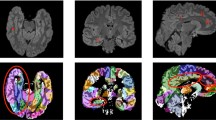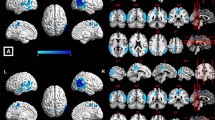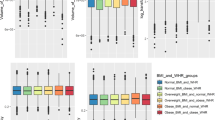Abstract
Excessive adipose tissue, particularly with a central distribution, consists of visceral fat, which is metabolically active and could impinge upon central nervous system functioning. The aim of the current study was to examine levels of visceral adiposity in relation to key cerebral metabolite ratios localized in the occipitoparietal grey matter. Seventy-three adults, aged between 40 and 60 years, underwent structural magnetic resonance imaging and single voxel 1H Magnetic Resonance Spectroscopy (1H MRS). Visceral fat was assessed using Dual Energy X Ray Absorptiometry (DXA). Individuals with higher visceral fat mass and volume had significantly lower ratios of N-acetyl-aspartate to total creatine (phosphocreatine + creatine, PCr + Cr) (NAA/PCr + Cr) (β = −0.29, p = 0.03, β = −0.28, p = 0.04). They also had significantly higher ratios of myo-inositol to total creatine (mI/PCr + Cr ) (β = 0.36, p = 0.01, β = 0.36, p = 0.01). Visceral fat mass and volume were not significantly related to ratios of glutamate to total creatine (Glu/PCr + Cr). While future studies are necessary, these results indicate central adiposity is associated with metabolic changes that could impinge upon the central nervous system in middle age.



Similar content being viewed by others
References
Andreassen OA, Jenkins BG, Dedeoglu A, Ferrante KL, Bogdanov MB, Kaddurah‐Daouk R et al (2001) Increases in cortical glutamate concentrations in transgenic amyotrophic lateral sclerosis mice are attenuated by creatine supplementation. J Neurochem 77(2):383–390
Brand A, Richter-Landsburg C, Leibfritz D (1993) Multinuclear NMR studies on the energy metabolism of glial and neuronal cells. Dev Neurosci 15:289–298
Bruno JL, Shelly EW, Quintin E-M, Rostami M, Patnaik S, Spielman D et al (2013) Aberrant basal ganglia metabolism in fragile X syndrome: a magnetic resonance spectroscopy study. J Neurodev Disord 5:20
Cereda E, Sansone V, Meola G, Malavazos AE (2007) Increased visceral adipose tissue rather than BMI as a risk factor for dementia. Age Ageing 36:488–491
Chen SQ, Wang PJ, Ten GJ, Zhan W, Li MH et al (2010) Role of myo-inositol by magnetic resonance spectroscopy in early diagnosis of Alzheimer's disease in APP/PS1 transgenic mice. Dement Geriatr Cogn Disord 28:558–566
Cloak CC, Chang L, Ernst T (2004) Increased frontal white matter diffusion is associated with glial metabolites and psychomotor slowing in HIV. J Neuroimmunol 157:147–152
Curtis JP, Selter JG, Wang Y, Rathore SS, Jovin IS, Jadbabaie F, Kosiborod M, Portnay EL, Sokol SI, Bader F, Krumholz HM (2005) The obesity paradox: body mass index and outcomes in patients with heart failure. J Am Med Assoc Intern Med 165:55–61
de Luca C, Olefsky JM (2008) Inflammation and insulin resistance. Fed Eur Biochem Soc Lett 582:97–105
Eagan DE, Gonzales MM, Tarumi T, Tanaka H, Stautberg S, Haley AP (2012) Elevated serum C-reactive protein relates to increased cerebral myoinositol levels in middle aged adults. Cardiovasc Psychiatry Neurol 2012:1–9
Fayed N, Andres E, Viguera L, Modrego PJ, Garcia-Campayo J (2014) Higher glutamate + glutamine and reduction of N-acetylaspartate in posterior cingulate according to age range in patients with cognitive impairment and/or pain. Acad Radiol 21:1211–1217
Fernando KT, Mclean MA, Chard DT, MacManus DG, Dalton CM, Miszkiel MA et al (2004) Elevated white matter myo-inositol in clinically isolated syndromes suggestive of multiple sclerosis. Brain 127:1361–1369
Ferrante RJ, Andreassen OA, Jenkins BG, Dedeoglu A, Kuemmerle S, Kubilus JK et al (2000) Neuroprotective effects of creatine in a transgenic mouse model of Huntington's disease. J Neurosci 20(12):4389–4397
Filley CM, Brown MS, Onderko K, Ray M, Bennett RE, Berry-Kravis E et al (2015) White matter disease and cognitive impairment in FMR1 premutation carriers. Neurology 84(21):2146–2152
Gasparovic C, Arfai N, Smid N, Feeney DM (2001) Decrease and recovery of N-acetylaspartate/creatine in rat brain remote from focal injury. J Neurotrauma 18(3):241–246
Gazdzinski S, Millin R, Kaiser LG, Durazzo TC, Mueller SG, Weiner MW et al (2010) BMI and neuronal integrity in healthy, cognitively normal elderly: a proton magnetic resonance spectroscopy study. Obesity (Silver Spring) 18:743–748
Gonzales MM, Tarumi T, Miles SC, Tanaka H, Shah F, Haley AP (2010) Insulin sensitivity as a mediator of the relationship between BMI and working memory-related brain activation. Obesity 18(11):2131–2137
Gonzales MM, Takashi T, Eagan DE, Tanaka H, Vaghasia M, Haley AP (2012) Indirect effects of elevated body mass index on memory performance through altered cerebral metabolite concentrations. Psychosom Med 74:691–698
Gonzales MM, Kaur S, Eagan DE, Goudarzi K, Pasha E, Doan DC, Tanaka H, Haley AP (2014) Central adiposity and the functional magnetic resonance imaging response to cognitive challenge. Int J Obes (Lond) 38(9):1193–1199
Grachev ID, Kumar R, Ramachandran TS, Szevereny NM (2001) Cognitive interference is associated with neuronal marker N-acetyl aspartate in the anterior cingulate cortex: an in vivo (1)H-MRS study of the Stroop color-word task. Mol Psychiatry 6:529–539
Gustafson DR (2010) Adiposity hormones and dementia. J Neurol Sci 299:30–34
Gustafson D, Rothenberg E, Blennow K, Steen B, Skoog I (2003) An 18-year follow up of overweight and risk of Alzheimer disease. Arch Intern Med 163:1524–1528
Haley AP, Gonzales MM, Tarumi T, Tanaka H (2013) Dyslipidemia links obesity to early cerebral neurochemical alterations. Obesity 21:2007–2013
Huang W, Alexander GE, Daly EM, Shetty HU, Krasuski JS, Rapopport SI et al (1999) High brain myo-inositol levels in the predementia phase of Alzheimer's disease in adults with Down's syndrome: a 1H MRS study. Am J Psychiatr 156:1876–1886
Isaac V, Sim S, Zheng H, Zagorodnov V, Tai ES, Chee M (2011) Adverse associations between visceral adiposity, brain structure and cognitive performance in healthy elderly. Front Aging Neurosci 3:12
Jenkins BG, Klivenyi P, Kustermann E, Andreassen OA, Ferrante RJ, Rosen BR et al (2000) Nonlinear decrease over time in N‐acetylaspartate levels in the absence of neuronal loss and increases in glutamine and glucose in transgenic Huntington's disease mice. J Neurochem 74(5):2108–2119
Jessen F, Block W, Traber F, Keller E, Flacke S et al (2001) Decrease of N-acetylaspartate in the MTL correlates with cognitive decline of AD patients. Neurology 57:930–932
Kantarci K, Jack CR, Campeau NG, O'Brien PC, Smith GE, Ivnik RJ, Boeve BF, Kokmen E, Tangalos EG et al (2000) Regional metabolic patterns in mild cognitive impairment and Alzheimer's disease: a H MRS study. Neurology 55:210–217
Kaur S, Gonzales M, Strasser B, Pasha E, McNeely J, Tanaka H, Haley AP (2015) Central adiposity & cortical thickness in midlife. Psychosom Med 77:671–678
Kernie SG, Leibl D, Parada LF (2000) BDNF regulates eating behavior and locomotor activity in mice. EMBO J 19:1290–1300
Kerwin DR, Gaussoin SA, Chlebowski RT, Kuller LH, Vitolins M, Coker LH et al (2011) Interaction between body mass index and central adiposity and risk of incident cognitive impairment and dementia: results from the Women's health initiative memory study. J Am Geriatr Soc 59:107–112
Kopelman P (2000) Obesity as a medical problem. Nature 404:635–643
Pan W, Kastin AJ (2007) Adipokines and the blood-brain barrier. Peptides 28:1317–1330
Qizilibash N, Gregson J, Johnson ME, Pearce N, Douglas I, Wing K et al (2015) BMI and risk of dementia in two million people over two decades: a retrospective cohort study. Lancet Diabetes Endocrinol 3(6):431–436
Ross AJ, Sachdev PS, Wen W, Valenzuela MJ, Brodaty H (2005) Cognitive correlates of H MRS measures in the healthy elderly brain. Brain Res Bull 66:9–16
Ross AJ, Sachdev PS, Wen W, Brodaty H, Joscelyn A, Lorentz LM (2006) Prediction of cognitive decline after stroke using proton magnetic resonance spectroscopy. J Neurol Sci 251:62–69
Signoretti S, Marmarou A, Tavazzi B, Lazzarino G, Beaumont A, Vagnozzi R (2001) N-acetylaspartate reduction as a measure of injury severity and mitochondrial dysfunction following diffuse traumatic brain injury. J Neurotrauma 18(10):977–991
Signoretti S, Marmarou A, Tavazzi B, Dunbar J, Amorini AM, Lazzarino G et al (2004) The protective effect of cyclosporin A upon N-acetylaspartate and mitochondrial dysfunction following experimental diffuse traumatic brain injury. J Neurotrauma 21(9):1154–1167
Spranger J, Verma S, Gurling I, Bobbert T, Selfert J, Sindler AL et al (2006) Adiponectin does not cross the blood-brain barrier but modifies cytokine expression of brain endothelial cells. Diabetes 55:141–147
Stern AJ, Savostyanova AA, Goldman A, Barnett AS, van der Veen JWC, Callicott JH et al (2008) Impact of the brain-derived neurotrophic factor Val66Met polymorphism on levels of hippocampal N-acetyl-aspartate assessed by magnetic resonance spectroscopic imaging at 3 tesla. Biol Psychiatry 64:856–862
Urenjak J, Williams SR, Gadian DG, Noble M (1992) Specific expression of N-acetyl aspartate in neurons, oligodendrocyte-type-2 astrocyte progenitors and immature oligodendrocytes in vitro. J Neurochem 59:55–61
Warren MW, Hynan LS, Weiner MF (2012) Lipids and adipokines as risk factors for Alzheimer's disease. J Alzheimers Dis 29:151–157
World Health Organization (2009) Global health risks: mortality and burden of disease attributable to selected major risks. World Health Organization, Geneva
Xia Y, Ergun DL, Wacker WK, Wang X, Davis CE, Kaul S (2014) Relationship between dual-energy x-ray apsorptiometry volumetric assessment and x-ray computed tomography-derived single slice measurement of visceral fat. J Clin Densitom 17(1):78–83
Zhang W, Wang PJ, Li MH, Wang GL, Li P, Gao ZL (2013) 1H-MRS assessment of the therapeutic effect of bilateral intraventricular BDNF infusion into APP/PS1 double transgenic mice. J Mol Neurosci 50:434–442
Acknowledgements
This work was made possible by funding provided by the National Institute of Neurological Disorders and Stroke (R01 NS075565, APH).
Author information
Authors and Affiliations
Corresponding author
Ethics declarations
Conflict of interest
The authors declare no conflict of interest.
Rights and permissions
About this article
Cite this article
Kaur, S., Birdsill, A.C., Steward, K. et al. Higher visceral fat is associated with lower cerebral N-acetyl-aspartate ratios in middle-aged adults. Metab Brain Dis 32, 727–733 (2017). https://doi.org/10.1007/s11011-017-9961-z
Received:
Accepted:
Published:
Issue Date:
DOI: https://doi.org/10.1007/s11011-017-9961-z




